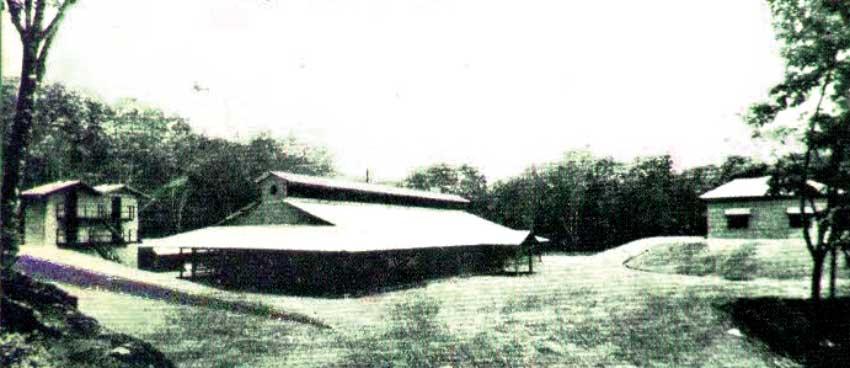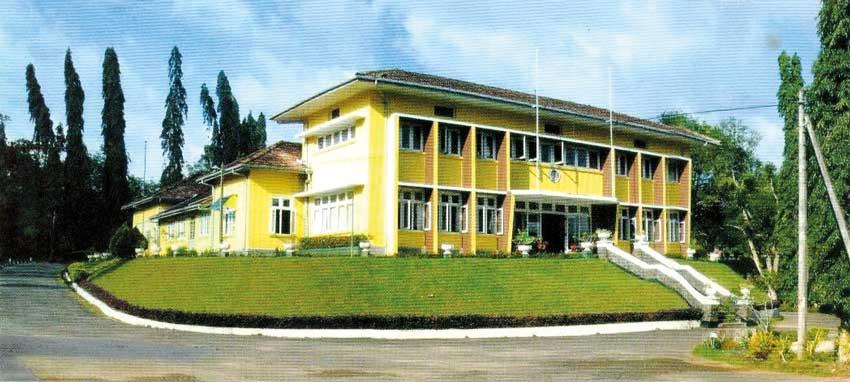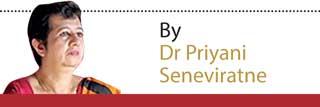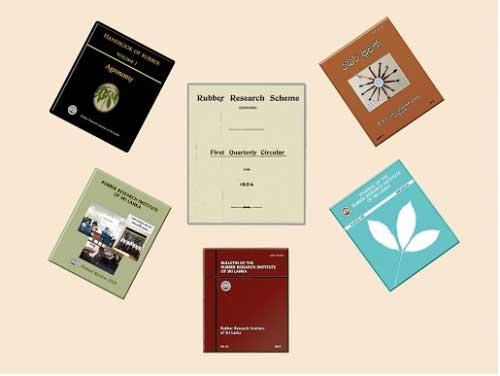Reply To:
Name - Reply Comment

The view of the Rubber Research Institute of Ceylon and the factory in 1935

Present appearance of the Rubber Research Institute of Sri Lanka which was built in 1961
The Rubber Research Institute of Sri Lanka, established in a remote rubber plantation namely Dartonfield, in the Kalutara District, is thriving in its original location from 1909 to date
The Rubber Research Institute has been the pioneer in Hevea breeding and a remarkable contribution was made to the industry by improving the genetic material of the plants, which enabled planters to harvest a yield that was more than ten times the crop obtained from the seedlings of Wickham’s collection
RRISL utilises highly developed nursery techniques, and the nursery monitoring system developed and adopted by the RRISL to monitor the plant production process, guarantees high-quality planting material for the farmers
With respect to latex processing, Sri Lanka produces the world’s purest and highest quality crepe rubber, which are largely used for pharmaceutical products and toys
 The Rubber Research Institute of Sri Lanka, the first in the world of its kind, dedicated to research on rubber, started off from very humble beginnings in 1909 with one scientist, an analytical chemist, involved in research related to rubber. The Smallholding Advisory Department had also been formed in later years to provide advisory services, and research findings had been disseminated through publications right from the beginning. The research work has undergone gradual and methodical expansion over the 112 years of its existence and publications of the institute also records a long history.
The Rubber Research Institute of Sri Lanka, the first in the world of its kind, dedicated to research on rubber, started off from very humble beginnings in 1909 with one scientist, an analytical chemist, involved in research related to rubber. The Smallholding Advisory Department had also been formed in later years to provide advisory services, and research findings had been disseminated through publications right from the beginning. The research work has undergone gradual and methodical expansion over the 112 years of its existence and publications of the institute also records a long history.
Our Publications
Annual Review, Journal of RRISL, Bulletin and Rubber Puwath, are mainly to report the research findings and are published annually. The Handbooks and Advisory circulars are not regular publications but published when the necessity arises. Annual Report is to report a summary of the performance of the institute to the Parliament.
Among the publications of the institute, “The Journal of the Rubber Research Institute of Sri Lanka” is a unique publication that provided a platform for the researchers to publish their findings and to share the knowledge with the rest of the world. This is exchanged with many national and international institutes on an exchange basis and its popularity is witnessed from the number of citations made by the researchers of the rubber growing world.
 This publication dates back to 1924 and has been published every year and this volume is the memorial 100th volume. The multiple issues in some years have reached the 100th volume within 96 years. The development of this publication over the years is a fascinating story. The first 16 volumes, from 1924 until 1939, had been published as four numbers quarterly under the title “Rubber Research Scheme (Ceylon) Quarterly Circulars”. The next five volumes (from volume 17 to 21), from 1940 to 1944 had been published as “Rubber Quarterly Circulars”.
This publication dates back to 1924 and has been published every year and this volume is the memorial 100th volume. The multiple issues in some years have reached the 100th volume within 96 years. The development of this publication over the years is a fascinating story. The first 16 volumes, from 1924 until 1939, had been published as four numbers quarterly under the title “Rubber Research Scheme (Ceylon) Quarterly Circulars”. The next five volumes (from volume 17 to 21), from 1940 to 1944 had been published as “Rubber Quarterly Circulars”.
Then from 1945 to 1958 (volumes 22-34), it carried the title “Rubber Research Institute Quarterly Circulars”. The 14 volumes from the year 1959 (Vol.35-49) had been published as “Rubber Research Institute of Ceylon Quarterly Journal” until 1972. After Sri Lanka became a republic in 1972, Ceylon was changed to Sri Lanka and the title of the Journal too changed to “Rubber Research Institute of Sri Lanka Quarterly Journal” for the three volumes from 50 to 53. The title “Journal of Rubber Research Institute of Sri Lanka” has been started from 1977 with volume 54 and remains unchanged up to volume 100, published in 2020.
While appreciating all the contributors from volume 1 up to 100, those who devoted themselves to publish it continuously, especially the library staff and the management of the institute are remembered with heartfelt gratitude.
It is the hope and the wish of all scientists at RRISL for the Journal of the Rubber Research Institute to prosper for another 100 years or more on the institute’s path to a radiant future.
Our Journey
The leading role played by Sri Lanka, Ceylon then, in the long journey of the domestication of the rubber tree from its wild Amazonian ancestors in 1876 is still a fascinating story to tell, and remembered by all rubber growing countries in South East Asia.
The specific events that took place in Sri Lanka, especially in research and development, are no less fascinating. The Rubber Research Institute of Sri Lanka, established in a remote rubber plantation namely Dartonfield, in the Kalutara District, is thriving in its original location from 1909 to date.
The original scheme had been reorganised in 1913 when it was named Rubber Research Scheme and the Government agreed to provide 60% of the expenses and the balance from the private subscribers. In 1914, the Rubber Growers’ Association, based in London inaugurated the Rubber Growers’ (Ceylon) Research fund to expand research activities. The Rubber Growers’ (Ceylon) Research Fund and Ceylon Rubber Research Scheme amalgamated the activities in 1920 with the contribution of 60% of the funds provided by the government. Planting and testing on new clones were initiated in a land of 65 acres at Nivithigalakale, in the Kalutara District in 1926.
The Smallholding Advisory Department was also formed in later years to provide advisory services and planting material for smallholder rubber growers at subsidised rates. This advisory unit was established in Colombo. The Rubber Research Ordinance of No.10 of 1930 was incorporated with the Rubber Research Scheme to operate in 1930. This ordinance provided provision to collect a cess of a one-eighth cent per pound of rubber exported and to utilise the same for research on rubber under a Board of Management. The Research station comprising of laboratories, factory and quarters had been formed in its present headquarters at Dartonfield Estate in Agalawatta in 1934 in a land of 178 acres. The very first building of the Rubber Research Institute shown here holds a historical value as the starting point of a research institute dedicated to rubber in the entire world. The research laboratories were slowly expanded and a factory was built to process the crop from the estate “Dartonfield Group” which is about 825 acres in extent and meant to conduct field trials on rubber agronomy.
In 1942, a further 1,000 acres of land was acquired from Hadigalla, close to Agalawatta, to expand research facilities for the growing demand and interest of the planters. The Rubber Research Scheme was named the Rubber Research Institute in 1951 by the provision of Rubber Research (Amendment) Act No.30 of 1951. The activities of the institute were expanded greatly in 1953 with the introduction of the subsidised rubber replanting scheme. The original Act of Parliament was amended again by the Rubber Research (Amended) Act No.39 of 1987. Since its establishment, the Rubber Research Institute has expanded according to the needs of the researchers and to fulfill the demands of the growers and the industry. “Nivithigalakale” was named the first substation which had already been established for testing clones, and it is about 10 km away and was one of the divisions of the Dartonfield group then. The second substation, named “Kuruwita” is 250 acres in extent and was opened in 1996 in the Ratnapura District about 125 km away in the wet zone. In 2004, another substation was established in the intermediate zone about 200 km away and 100 acres in size. The most recently established substations in the Southern Province of the country, belonging to the intermediate zone with an area of 62 acres.
Contribution to the Industry
In order to manage the available research staff and other physical resources effectively to cater to the needs of the rubber cultivation and product manufacturing industry, different research disciplines have been identified. At present, the research on agronomy is divided into Genetics & Plant Breeding, Plant Pathology & Microbiology, Plant Science, Soils & Plant Nutrition, and Biochemistry. Some units have also been formed to support the research work of main departments, namely Biometry, Agricultural Economics and Adaptive Research. Research laboratories of the Rubber Chemistry Department were later moved to a building in the Colombo District to help the rubber manufacturing sector especially for troubleshooting, product development and for issuing of testing and analytical reports. The Rubber Chemistry Department was further divided into four departments in 1988 namely, Rubber Technology, Polymer Chemistry, Raw Rubber & Chemical Analysis and Raw Rubber Process Development & Chemical Analysis, to handle research and development
more effectively.
Genetics and Plant Breeding is one of the main disciplines identified from the very beginning. The research department is situated in the Nivithigalakale substation, close to the main station, and it is the site of origin of all the world recognised clones. The Rubber Research Institute has been the pioneer in Hevea breeding and a remarkable contribution was made to the industry by improving the genetic material of the plants, which enabled planters to harvest a yield that was more than ten times the crop obtained from the seedlings of Wickham’s collection. Disease resistant clones recommended through thorough screening methods have guaranteed plantations free from chemical spraying to control foliar diseases, thus paving the way to a safer environment while saving the cost incurred. During the olden days, the Rubber Research Institute had to persuade planters for sulphur dusting to protect the plantations from Oidium leaf disease on clones planted until the 1950s. Having witnessed the disease resistance especially to Oidium, in the fields planted with new clones, and disease incidences and severity not being frequent enough and severe enough to undertake foliar spraying, the Rubber Research Institute recommended stopping sulphur dusting in Sri Lanka. Apart from the worldwide large scale adoption of RRIC clones, they are used by rubber breeders across the world in their hand pollination programmes to develop clones with
disease resistance.
Yet, the new leaf fall disease reported in Sri Lanka for the first time in 2019 is spreading in rubber plantations affecting all the clones planted today. Trials are being carried out in search of controlling measures and an interim chemical recommendation has been issued to delimit further spread. Rainy and overcast weather prevailed from May onwards this year has favoured the pathogen to grow while affecting the chemical spraying programmes. The best disease-resistant clone RRIC 100 is added back to the group I of the list of recommended clones from this year and the clone RRIC 121 is withdrawn temporarily due to its over usage covering over 70% of the extent.
RRISL utilises highly developed nursery techniques, and the nursery monitoring system developed and adopted by the RRISL to monitor the plant production process, guarantees high-quality planting material for the farmers. Since the rubber plantations in Sri Lanka span across several climate zones, RRISL has paid special attention towards providing irrigation systems that are specifically tailored to suit the requirements of the different zones. One such example is the sprinkler irrigation system which was developed for nurseries especially in the intermediate zone of the country. Slow-release fertilizer embedded coir bricks and porous tubes filled with fertilizer have increased efficiency of fertilizer use, whereas film bio-fertilizers and biochar applications and use of liquid herbal preparations as fertilizer are recommended for nurseries and immature plantations.
With respect to latex processing, Sri Lanka produces the world’s purest and highest quality crepe rubber, which are largely used for pharmaceutical products and toys. Value-added novel sole crepe rubber material with greater hardness, improved abrasion resistance and smoother surfaces have been developed for the product manufacturing industry. Scientists have invented safer and more effective chemicals for the processing of various types and products of natural rubber, making the rubber products suitable even to contact with food. Sri Lanka is leading the glove industry through manufacturing and introducing a variety of types from surgical gloves to industrial glove types including the invention of rubber-based adhesive for the glove industry.
Effective knowledge dissemination for both the RPC managed estates and smallholder sector farmers through novel techniques such as Technology Transfer Centres and Social media applications are among the prospective interests of the Rubber Research Institute to increase the local rubber productivity through technology adoption.
Today rubber is a profitable agricultural commodity due to its extensive utilisation in diverse domestic and global manufacturing projects. With a contribution of around 1% to the Gross Domestic Production in Sri Lanka, the interest of all stakeholders in the rubber industry has escalated. And with the RRISL spearheading this expansion, the rubber industry of Sri Lanka is on the path to a radiant future.
The writer is the Deputy Director-Research (Bio) attached to the Rubber Research Institute of Sri Lanka, Dartonfield, Agalawatta.